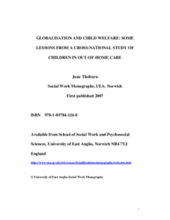Globalisation impacts on child welfare policies as well as on related policy areas, such as anti-poverty strategies. National and local government agencies are using research and practitioner and policy maker exchanges to learn from other countries in order to improve outcomes for vulnerable children and families. Social work programmes at Masters and Doctoral levels are establishing collaborative links and exchange schemes between academics, researchers and social work managers in countries with diverse needs and populations.
There are also pitfalls associated with incorporating research findings and practice interventions from one country into the policy and practice of another. Alongside peer-reviewed research, routinely-collected administrative data can provide necessary context for these cross-national debates and initiatives. But even with these large data sets, inappropriate comparisons between apparently successful interventions in different countries can lead to misleading conclusions and inappropriate policy changes.
This Monograph aims to build awareness of similarities and differences between children in need of child welfare services in apparently similar countries, and in different states within the same country. The study focused on ‘post-industrial’ societies with broadly similar economies and developed, though differing, child welfare systems. In discussions with policy makers, data analysts and researchers in these countries, possible explanations for these differences were identified.
In this Monograph, a brief commentary on the nature of the data is followed by an account of the use made of out-of-home care in the countries studied. This is followed by a more detailed account on the four UK nations. The concluding chapter discusses the impact of the differences identified. This is followed by a discussion of the impact these contextual and policy differences may have on the rates in out-of-home care in apparently similar countries, and how these differences may impact on outcomes for the young people. It must be stressed at this stage that this is not an in-depth analysis of the child welfare systems in these countries, nor does it seek to compare in any depth the systems for providing out-of-home care. The focus here is on the data and the contextual factors that may be contributing to similarities and differences.
©University of East Anglia Social Work Monographs

